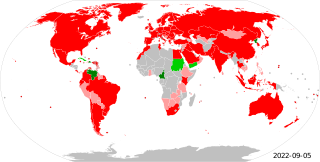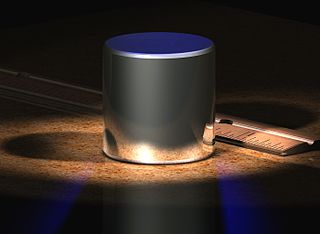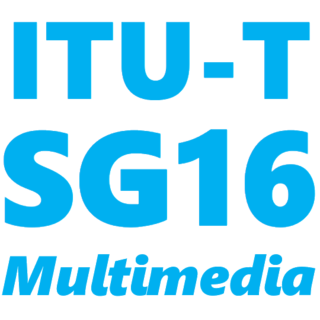
The International Bureau of Weights and Measures is an intergovernmental organisation, through which its 59 member-states act together on measurement standards in four areas: chemistry, ionising radiation, physical metrology, as well as Coordinated Universal Time. It is based in Saint-Cloud, near Paris, France. The organisation has been referred to as IBWM in older literature.
The General Conference on Weights and Measures is the supreme authority of the International Bureau of Weights and Measures (BIPM), the intergovernmental organization established in 1875 under the terms of the Metre Convention through which member states act together on matters related to measurement science and measurement standards. The CGPM is made up of delegates of the governments of the member states and observers from the Associates of the CGPM. Under its authority, the International Committee for Weights and Measures executes an exclusive direction and supervision of the BIPM.

The litre or liter is a metric unit of volume. It is equal to 1 cubic decimetre (dm3), 1000 cubic centimetres (cm3) or 0.001 cubic metre (m3). A cubic decimetre occupies a volume of 10 cm × 10 cm × 10 cm and is thus equal to one-thousandth of a cubic metre.

The Moving Picture Experts Group (MPEG) is an alliance of working groups established jointly by ISO and IEC that sets standards for media coding, including compression coding of audio, video, graphics, and genomic data; and transmission and file formats for various applications. Together with JPEG, MPEG is organized under ISO/IEC JTC 1/SC 29 – Coding of audio, picture, multimedia and hypermedia information.
MPEG-4 is a group of international standards for the compression of digital audio and visual data, multimedia systems, and file storage formats. It was originally introduced in late 1998 as a group of audio and video coding formats and related technology agreed upon by the ISO/IEC Moving Picture Experts Group (MPEG) under the formal standard ISO/IEC 14496 – Coding of audio-visual objects. Uses of MPEG-4 include compression of audiovisual data for Internet video and CD distribution, voice and broadcast television applications. The MPEG-4 standard was developed by a group led by Touradj Ebrahimi and Fernando Pereira.

The Metre Convention, also known as the Treaty of the Metre, is an international treaty that was signed in Paris on 20 May 1875 by representatives of 17 nations: Argentina, Austria-Hungary, Belgium, Brazil, Denmark, France, Germany, Italy, Peru, Portugal, Russia, Spain, Sweden and Norway, Switzerland, Ottoman Empire, United States of America, and Venezuela.

JPEG 2000 (JP2) is an image compression standard and coding system. It was developed from 1997 to 2000 by a Joint Photographic Experts Group committee chaired by Touradj Ebrahimi, with the intention of superseding their original JPEG standard, which is based on a discrete cosine transform (DCT), with a newly designed, wavelet-based method. The standardized filename extension is .jp2 for ISO/IEC 15444-1 conforming files and .jpx for the extended part-2 specifications, published as ISO/IEC 15444-2. The registered MIME types are defined in RFC 3745. For ISO/IEC 15444-1 it is image/jp2.

Metrology is the scientific study of measurement. It establishes a common understanding of units, crucial in linking human activities. Modern metrology has its roots in the French Revolution's political motivation to standardise units in France when a length standard taken from a natural source was proposed. This led to the creation of the decimal-based metric system in 1795, establishing a set of standards for other types of measurements. Several other countries adopted the metric system between 1795 and 1875; to ensure conformity between the countries, the Bureau International des Poids et Mesures (BIPM) was established by the Metre Convention. This has evolved into the International System of Units (SI) as a result of a resolution at the 11th General Conference on Weights and Measures (CGPM) in 1960.

The Joint Photographic Experts Group (JPEG) is the joint committee between ISO/IEC JTC 1/SC 29 and ITU-T Study Group 16 that created and maintains the JPEG, JPEG 2000, JPEG XR, JPEG XT, JPEG XS, JPEG XL, and related digital image standards. It also has the responsibility for maintenance of the JBIG and JBIG2 standards that were developed by the former Joint Bi-level Image Experts Group.
MPEG-4 Part 2, MPEG-4 Visual is a video compression format developed by the Moving Picture Experts Group (MPEG). It belongs to the MPEG-4 ISO/IEC standards. It uses block-wise motion compensation and a discrete cosine transform (DCT), similar to previous standards such as MPEG-1 Part 2 and H.262/MPEG-2 Part 2.
JPEG XR is an image compression standard for continuous tone photographic images, based on the HD Photo specifications that Microsoft originally developed and patented. It supports both lossy and lossless compression, and is the preferred image format for Ecma-388 Open XML Paper Specification documents.
The Video Coding Experts Group or Visual Coding Experts Group is a working group of the ITU Telecommunication Standardization Sector (ITU-T) concerned with standards for compression coding of video, images, audio, and other signals. It is responsible for standardization of the "H.26x" line of video coding standards, the "T.8xx" line of image coding standards, and related technologies.
Gary Joseph Sullivan is an American electrical engineer who led the development of the AVC, HEVC, and VVC video coding standards and created the DirectX Video Acceleration (DXVA) API/DDI video decoding feature of the Microsoft Windows operating system.
ISO/IEC JTC 1, entitled "Information technology", is a joint technical committee (JTC) of the International Organization for Standardization (ISO) and the International Electrotechnical Commission (IEC). Its purpose is to develop, maintain and promote standards in the fields of information and communications technology (ICT).
The ISO base media file format (ISOBMFF) is a container file format that defines a general structure for files that contain time-based multimedia data such as video and audio. It is standardized in ISO/IEC 14496-12, a.k.a. MPEG-4 Part 12, and was formerly also published as ISO/IEC 15444-12, a.k.a. JPEG 2000 Part 12.

In metrology, a standard is an object, system, or experiment that bears a defined relationship to a unit of measurement of a physical quantity. Standards are the fundamental reference for a system of weights and measures, against which all other measuring devices are compared. Historical standards for length, volume, and mass were defined by many different authorities, which resulted in confusion and inaccuracy of measurements. Modern measurements are defined in relationship to internationally standardized reference objects, which are used under carefully controlled laboratory conditions to define the units of length, mass, electrical potential, and other physical quantities.

The following outline is provided as an overview of and topical guide to the metric system – various loosely related systems of measurement that trace their origin to the decimal system of measurement introduced in France during the French Revolution.
ISO/IEC JTC 1/SC 29, entitled Coding of audio, picture, multimedia and hypermedia information, is a standardization subcommittee of the Joint Technical Committee ISO/IEC JTC 1 of the International Organization for Standardization (ISO) and the International Electrotechnical Commission (IEC). It develops and facilitates international standards, technical reports, and technical specifications within the field of audio, picture, multimedia, and hypermedia information coding. SC 29 includes the well-known JPEG and MPEG experts groups, and the standards developed by SC 29 have been recognized by nine Emmy Awards.

The ITU-T Study Group 16 (SG16) is a statutory group of the ITU Telecommunication Standardization Sector (ITU-T) concerned with multimedia coding, systems and applications, such as video coding standards. It is responsible for standardization of the "H.26x" line of video coding standards, the "T.8xx" line of image coding standards, and related technologies, as well as various collaborations with the World Health Organization, including on safe listing (H.870) accessibility of e-health (F.780.2), it is also the parent body of VCEG and various Focus Groups, such as the ITU-WHO Focus Group on Artificial Intelligence for Health and its AI for Health Framework.